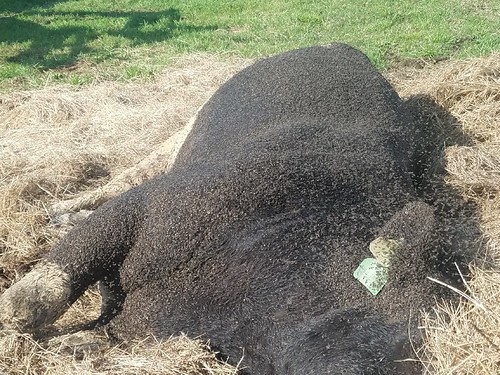Producers, extension agents brace for possible return of buffalo gnat outbreaks in Arkansas County
By Ryan McGeeney
U of A System Division of Agriculture
March 15, 2019
Fast Facts:
- River levels, temperatures similar to 2018 conditions
- 2018 outbreak believed to have killed about 100 domesticated animals, at least 280 deer
- Burning of hay, permethrin applications to individual animals may help control potential outbreak
(412 words)
(Newsrooms: with art at https://www.flickr.com/gp/uacescomm/5R7Gem)
(Download this story in MS Word format here.)
DEWITT, Ark. — Livestock producers and Cooperative Extension Service agents in Arkansas County are bracing for another possible outbreak of southern buffalo gnats.
In 2018, such an outbreak, which lasted from about March 15 to about April 15, caused the death of about 100 domesticated animals and at least 280 deer in the area.
Kelly Loftin, extension entomologist for the University of Arkansas System Division of Agriculture, said spring flooding in the White River contributed to especially large populations of the southern buffalo gnat, a type of black fly that breeds in running water. He said that river levels are similar to those seen this same time last year, and current water temperatures are ideal for the insect’s reproduction.
“Water temperatures are in the high 50’s, low 60’s,” Loftin said, “which are prime breeding temperatures for the buffalo gnat. Comparing the river levels to a four-month period in 2018 during the outbreak, they’re very similar, if not a little higher this year.
“County agents in Arkansas County are encountering heavier populations of buffalo gnats than they see in most years,” he said. “However, it hasn’t reached the intensity that it reached in 2018.”
Grant Beckwith, staff chair for the Arkansas County Cooperative Extension Service office, said some landowners have already begun burning hay and cross ties, as well as treating individual cattle with permethrin insecticides, both considered effective methods of controlling the insect.
“I’ll be touring the county next week to see where buffalo gnat populations are intensifying,” Beckwith said. “In all likelihood, we’ll already be seeing some dead animals.”
Southern buffalo gnats, in large numbers, tend to kill animals in a number of ways, the most common of which is toxemia — specifically, a toxic reaction to the anticoagulants in the gnats’ salivary glands. They can also kill through sheer blood loss, known as exsanguination, or by suffocation, if an animal’s airway is blocked for a prolonged period of time.
Beckwith said he and other county agents have advised residents to alert Arkansas Game and Fish officials to any dead deer or other wildlife, in order to establish the best possible estimate of the insects’ effects on the area, and to update the Cooperative Extension Service office if any livestock or other domesticated animal appears to fall victim to the insects, in order to fully understand the outbreak’s economic impact.
To learn about pest control in Arkansas, contact your local Cooperative Extension Service agent or visit www.uaex.uada.edu. Follow us on Twitter at @AR_Extension.
About the Division of Agriculture
The University of Arkansas System Division of Agriculture’s mission is to strengthen agriculture, communities, and families by connecting trusted research to the adoption of best practices. Through the Agricultural Experiment Station and the Cooperative Extension Service, the Division of Agriculture conducts research and extension work within the nation’s historic land grant education system.
The Division of Agriculture is one of 20 entities within the University of Arkansas System. It has offices in all 75 counties in Arkansas and faculty on five system campuses.
Pursuant to 7 CFR § 15.3, the University of Arkansas System Division of Agriculture offers all its Extension and Research programs and services (including employment) without regard to race, color, sex, national origin, religion, age, disability, marital or veteran status, genetic information, sexual preference, pregnancy or any other legally protected status, and is an equal opportunity institution.
# # #
Media Contact: Ryan McGeeney
Communication Services
U of A System Division of Agriculture
Cooperative Extension Service
(501) 671-2120
rmcgeeney@uada.edu
